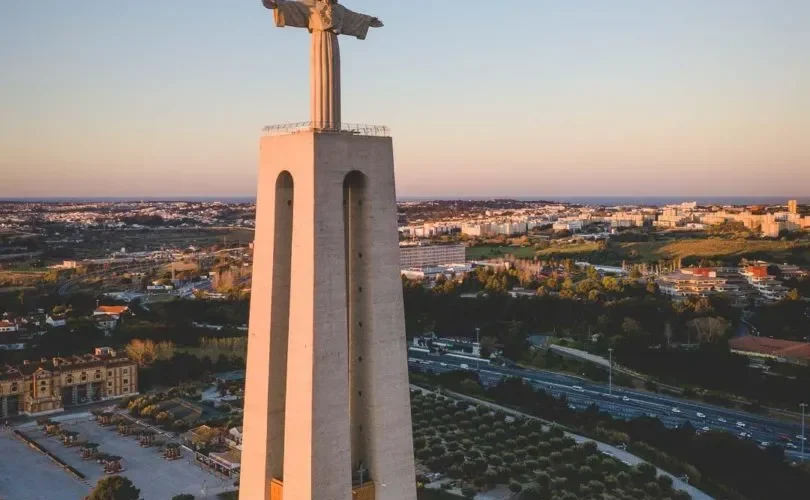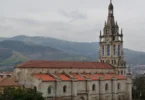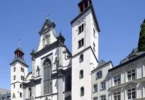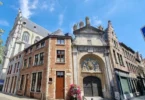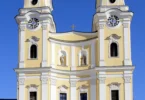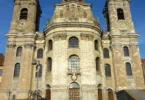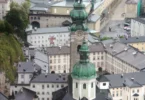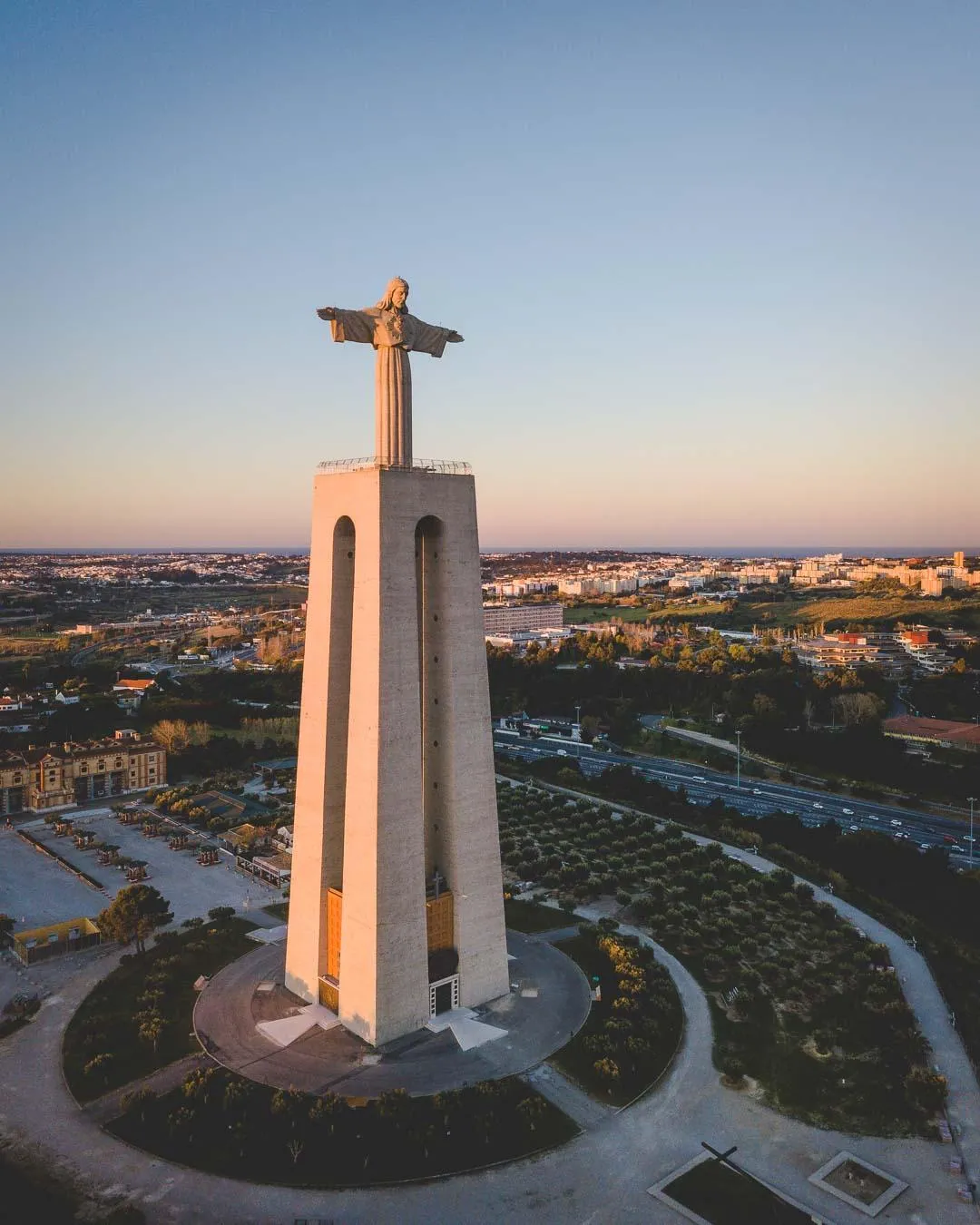
Introduction
The Sanctuary of Christ the King (Portuguese: Santuário de Cristo Rei) is a Catholic monument and shrine dedicated to the Sacred Heart of Jesus Christ overlooking the city of Lisbon situated in Almada, in Portugal. It was inspired by the Christ the Redeemer statue of Rio de Janeiro, in Brazil, after the Cardinal Patriarch of Lisbon visited that monument. The giant statue was erected to express gratitude because the Portuguese were spared the direct destructive effects of World War II.
The desire to build a monument to Christ the King began in 1940 when the Portuguese bishops vowed to build a Monument to the Sacred Heart of Jesus over Lisbon if Portugal were spared from the War. Portugal maintained a position of neutrality in World War II, not participating directly in war actions and this fact was decisive in launching a national fundraising campaign, so that the construction could become a reality. And finally in 1959 the Monument to Christ the King was inaugurated, rising 113 meters over the cities of Almada and Lisbon, offering a 360º panoramic view over both banks of the Tagus River and surrounding areas.
Within the four pillars of the Monument to Christ the King, symbol of the four cardinal points, is the Chapel of Our Lady of Peace, designed by Architect António Lino. The image of Our Lady is the work of Master Leopoldo de Almeida, being a replica of the same image that was offered to the Church of Santo Eugénio in Rome, on the occasion of the Holy Year of 1950. On May 17, 2006, the chapel was deeply remodeled, with changes to the Main Chapel and the Chapel of the Blessed Sacrament. These changes included the collaboration of architect João de Sousa Araújo.

The idea of building the Monument to Christ the King emerged in 1934, during a visit to Brazil by the then Cardinal Patriarch of Lisbon, D. Manuel Gonçalves Cerejeira. As he passed through Rio de Janeiro, he saw the imposing image of Christ the Redeemer on Corcovado and soon the desire to build a similar work in front of Lisbon was born in his heart.
In 1936, the idea of building the Monument to Christ the King was transmitted to the “Apostolate of Prayer”, which enthusiastically welcomed it. To be National, the Monument needed approval and cooperation from all Portuguese Bishops. Such awareness among the Bishops was achieved and was officially proclaimed in the Collective Pastoral of Lent of 1937.
The construction of the Christ the King monument was approved in a Portuguese Episcopate conference, held in Fatima on 20 April 1940, as a plea to God to release Portugal from entering World War II
Given this social and political context experienced in the 1930s, the Portuguese Bishops pointed out three reasons for the construction of the Monument to Christ the King:
- The duty of social reparation for the universal conspiracy of Christ
- A great duty of national gratitude, because unlike other countries, in Portugal, through a singular providence, people lived in peace, in spiritual progress and the monument would thus be a deep and heartfelt gratitude to Christ.
- A demand for national restoration
In 1939, World War II began and it was during this period that the idea of building the Monument to Christ the King gained new meaning and vigour.
On April 20, 1940, in Fatima, the national bishops, at the end of their annual Retreat, formulated the following vote: “If Portugal were spared from the War, a Monument to the Sacred Heart of Jesus would be erected over Lisbon, a sign visible of how God, through Love, wishes to conquer all humanity for Himself.”
Portugal maintained a position of neutrality in World War II, not participating directly in war actions and this fact was decisive in launching a national fundraising campaign, so that the construction could become a reality. However, this campaign became slow due to the war context. Even so, and despite all the difficulties, in 1941 the land was acquired for the construction of the Monument.
About a year after the end of World War II, on January 18, 1946, in the Pastoral Colectiva, the Portuguese Episcopate, in addition to referring to the 3rd Centenary of the Coronation of Our Lady of Conception as Patron Saint of Portugal, formally declared that it had the promise to erect the Monument to Christ the King and, from then on, the fundraising campaign actively intensified.
We must also refer to the participation of all Portuguese children in the fundraising campaign for the construction of the Monument, a campaign called “Pedras Pequeninas” extending from 1939 to 1958.The principle that guided this campaign was above all the value of children’s sacrifice and the effectiveness of their prayer.
Throughout the year, the children renounced something, placing this renunciation in a piggy bank that was then deposited in the Nativity Scene of their Parishes on the day of the Holy Innocents (December 28th).It should be noted that this Campaign generated around €7,500.00.
In the city of Porto, coincidentally the “City of the Virgin”, lived Sister Mary of the Divine Heart, who influenced Pope Leo XIII to determine the consecration of the entire human race to the Heart of Jesus. In 1949, the 50th anniversary of this magnificent religious event was celebrated and this reason led Cardinal Cerejeira to purposely choose that year. On December 18th, the 1st Stone of the Monument to Christ the King is solemnly laid.
Two years later, work began on the foundations and finally in 1952, the company Obras Públicas e Cimento Armado (OPCA) began construction of the foundations. The work was carried out using a special formwork system, that is, the so-called traveling molds, in which the scaffolding was the structure itself, receiving the concrete, in which the pedestal of the image of Christ the King could be seen growing, layer after layer.
In total, around 40 thousand tons of concrete were used. After being built, it was sculpted by hand in meticulous work, carried out more than a hundred meters above the ground.It is important to note that no man died in the construction of this imposing monument.
On May 17, 1959 (Pentecost Day) before the image of Our Lady of Fátima, with the participation of the entire Portuguese Episcopate, the Cardinals of Rio de Janeiro and Lourenço Marques (Maputo), civil authorities and 300 thousand people , the Monument was inaugurated. His Holiness, Pope John XXIII was present by Radio message. On the occasion, Cardinal Cerejeira made an eloquent statement: “This will always be a sign of National Gratitude for the gift of Peace”.
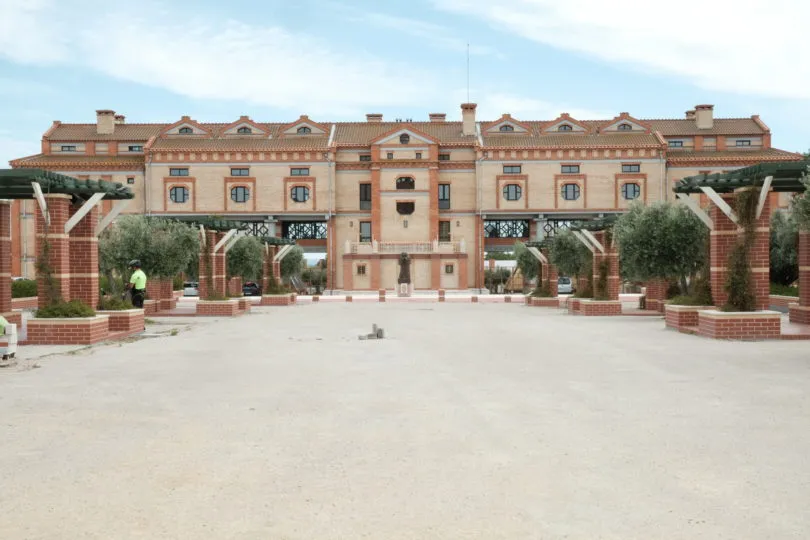
Reception Building was designed by architect Luís Cunha; it was inaugurated in 1996 and completed in 2007. To adapt to the pastoral and spiritual needs of the Sanctuary, it underwent some changes inside, without damaging the original design.
Its valences are diverse. In the basements there are dormitories for young people and cafeterias with capacity for 350 people. The rectory with its administrative services operates in this building. It has some rooms and halls to welcome groups that come to us for days of reflection and training.
On the upper floor, there is the Female Religious Community of the Apostles of the Sacred Heart of Jesus, who support the Sanctuary in the various services to welcome pilgrims.
In this building you will find the Chapel of the Divine Heart, opened in 2011, which features 3 oil paintings alluding to the biblical foundations of devotion to the Sacred Heart of Jesus, 12 stained glass windows that represent the 12 promises of Jesus to Saint Margaret Mary Alacoque in the 19th century. XVII and a tiled panel referring to Eucharistic Adoration.
It is worth highlighting the presence of 10 paintings in the corridors alluding to Portuguese Saints, among other existing paintings, as well as a sculpture of the Sacred Heart of Jesus by the sculptor Marco Augusto Dueñas. Next to the Reception Building is the statue of Blessed Maria do Divino Coração, inaugurated on the sixtieth anniversary of the Sanctuary, on May 17, 2019.
Alameda Pio XII construction began in 2014 and is scheduled for completion in 2020. This promenade connects the reception building to the Monument, so that anyone who enters the Sanctuary on foot realizes that they are entering a spiritual place that invites them to prepare to enter the heart of the Sanctuary, which is the Monument to Christ the King.
At the beginning of this path is the statue of Pope Pius XII, since it was this Pontiff who wrote the great Encyclical Aurietis Aguas , on devotion to the Sacred Heart of Jesus. This boulevard is made up of 8 pergolas which, in time, will be covered in natural greenery, flanked by flower beds.
In each pergola there are 2 music columns that broadcast daily classical music and Gregorian chant with the aim of creating a welcoming environment in the Sanctuary and helping pilgrims realize that the place is sacred. In the centre, a stone path will be built made up of symbols of the pilgrimage that ends in a lake of water that aims to remember Christian Baptism.
In 1984, celebrating the 25th Anniversary of the Sanctuary of Christ the King, a General Planning Plan for the Sanctuary’s grounds was approved, designed by architects Luiz Cunha and Domingos Ávila Gomes. From this project, the Sanctuary Reception Building was built, where the Rectory and Administrative Services operate, as well as a Chapel, Meeting Rooms and galleries for exhibitions.
In June 1999, the Sanctuary came under the supervision of the Diocese of Setúbal. Immediate priority was given to the restoration of the Monument. With technical support from Universidade Nova de Lisboa – Faculty of Science and Technology. The works began in May 2001, and the Monument was solemnly reopened on the 1st of February 2002. Confirming its nature as a National Sanctuary, it was decided by the Portuguese Episcopal Conference that the Offertories throughout the country on 23/11/2003 would revert to help pay for restoration work.
In June 2004, a cafeteria with capacity for 150 people and two dormitories for young people with capacity for eleven girls and ten boys were opened. On May 17, 2005, the João Paulo II Multipurpose Hall was inaugurated, comprising a cafeteria for 150 people and a room for 80 people.
On the same day, the “Youth Space” came into operation, consisting of two dormitories with capacity, one for 22 and the other for 30 people, a cafeteria for 55 people and a kitchen. All this equipment was made to better serve pilgrims who visit us in organized groups, namely Retreats and Recollections.
In 2006, improvements began to the Monument to Christ the King, namely on May 17th, work was inaugurated on the Chapel of Nossa Senhora da Paz, with the collaboration of the Architect João de Sousa Araújo.
On May 17, 2007, the Blessed John XXIII Room was inaugurated, containing eight oil paintings alluding to the Encyclical “Pax in Terris”, by this Pope and a statue of the Angel of Portugal, all by the same architect. The space surrounding the elevator area was also opened.
On that same day, the old High Cross of the Sanctuary of Fátima was placed in front of the Monument, offered to the Sanctuary of Christ the King and months later, on November 25, 2007, the renovation of the Main Sacristy of the Monument Chapel was inaugurated, including the restoration of the original model of the image of Christ the King, by sculptor Francisco Franco.
On Christ the King Sunday of the same year, a Way of the Cross was inaugurated in the Monument Chapel, which at each Station corresponds the Passion of Christ with the current world situation.
On January 6, 2009, in the Chapel of the Blessed Sacrament, two paintings are inaugurated alluding to the revelations that Jesus made to Saint Margaret Maria Alacoque, and another that tops the Tabernacle”.
On May 17, 2008, the “Chapel of the Confidants of the Heart of Jesus” was inaugurated, containing the relics of Saint Margaret Mary Alacoque, Saint John Eudes, Beata Mary of the Divine Heart and Saint Faustina Kowalska. On this day, the bronze “Ten Commandments” were also inaugurated and placed on the main front of the monument.
Monument of Christ the King

The monument was erected on an isolated clifftop 133 m above the sea, overlooking the Tagus River left bank. It was constructed in the parish of Pragal, which was merged with the parishes of Almada, Cova da Piedade, Pragal e Cacilhas in 2013, into the municipality of Almada. It is the highest point in Almada, on a plateau dominated by the 25 de Abril Bridge, and close to the Estação Elevatória e Reservatório do Pragal. It is accessible from Lisbon by car (over the 25 de Abril Bridge east of the crossing), by train through station in Pragal and by ferry (the Cacilheiro) over the Tagus, through the port of Cacilhas in Almada.
The monument consists of a trapezoidal pedestal of 82 metres (269 ft) height, formed by four arches and a flat platform, supporting the 28 metres (92 ft) image of Christ. The monument features a reinforced concrete volume of 20,000 m³, a total construction weight of 40,000 tons, a footing depth of 14 m, and ensures a minimum visibility distance of 20 km. Its base was designed by architect António Lino in the form of a gate, while the statue of Christ the King was designed by sculptor Francisco Franco de Sousa.
The image of Christ the King, with arms like a cross, was a requirement of art, so that it could be visible in the contours of his human figure, without being confused with the uniform figure raised in a straight line upwards. His heart is clearly visible, in a gesture demonstrating the way in which Jesus wants to win all of Humanity for Himself, through the path of Love.
The entire set is 110 meters high, 28 from the image and 82 from the pedestal. The base of the Monument is 625 m2, corresponding to 25 meters per face. The four arches of the pedestal are oriented in the directions of the compass rose. The figure of Christ, comparable to the Christ the Redeemer statue in Rio de Janeiro, forms a cross, with its arms extended out facing the city of Lisbon, as if to embrace the city. Due to issues of security and safety, the monument was sufficiently distanced from the cliffs on which it predominates.
At the base of the statue is the observation deck, at 82 metres (269 ft), which enables panoramic views of the city of Lisbon, the Tagus River and the 25 de Abril Bridge.
Under the statue, occupying a fifth of the pedestal’s height is the Chapel of Our Lady of Peace (Nossa Senhora da Paz) with an entrance from the northern facade. This space is distinctly different with its masonry stone, the northern facade surmounted by cross and the other facades containing narrow doors. Inside two of the pillars is an elevator system with access to the terrace; the statue is 79.30 metres high, and overlooks the Tagus (192 metres above the river).
To the south of the monument is the Sanctuary building, comprising a rectangular body of three wings, with facades covered with masonry brick. In 1987 there was a plan to construct 18 different buildings and spaces around the monument (including a restaurant, lookouts, a commercial complex, a parking area, and a sanctuary), of which only a few of these structures were built. The most notable was the construction of the visitors’ centre and the Sanctuary building.
The interior of the monument is divided into various spaces, among them a library, a bar, two halls and the main chapel. Two religious spaces were dedicated, one to the Chapel of Our Lady of Peace (Portuguese: Capela de Nossa Senhora da Paz) and the other to the Confidants of Jesus (Portuguese: Capela dos Confidentes de Jesus). There are relics exposed for public veneration (of Margaret Mary Alacoque, John Eudes, Faustina Kowalska, and Mary of the Divine Heart), relating to the revelations of the Sacred Heart of Jesus).
Main door
The Monument’s current door was inaugurated on May 17, 2016. In the centre, you can see the figure of Christ the Good Shepherd, who carries in his hands the sheep that needs special care. With his tender gaze, he invites others to enter his fold, an attitude shown in the sculptures of the other ten sheep that make their way into the Monument.
The entire door grille is an allusion to the burning bush that Moses saw on Mount Sinai. On the left side we see his sandals, which represent the attitude of this ancient patriarch, when he heard the voice of God asking him to take off his shoes, as the ground he was walking on was sacred. This allusion invites the pilgrim to enter the Monument with respect, a sacred space as well. Above is Jesus’ phrase: “I am the door”, thus indicating that He Himself is the way to reach God the Father. Immediately afterwards is an oval shield alluding to the twelve promises that Jesus made to Saint Mary Alacoque in sec. XVIII.
Porticos
The Catholic Faith is based on four pillars: Commandments of the Law of God, Sacraments, Creed, and Prayer. In this way, the four porticoes of the Monument allude to these four catechetical themes, represented in bronze bas-reliefs.
In the gospels we find these pillars founded, so around the pedestal of Christ the King flanking the 4 porticos you can find the 4 evangelists represented (Saint Mark, Saint Matthew, Saint Luke, and Saint John).
On the north side , flanking the main door are the Ten Commandments given by God to Moses, represented by several figures. Each bas-relief represents a commandment. The south side is dedicated to the Prayer of the Church. Outside this portico is the Our Father, represented with his seven petitions.
Inside we see the three Evangelical Songs: the Magnificat , words spoken by Our Lady, when she hears the greeting of her cousin Saint Elizabeth; the Benedictus , which is prayed by Zechariah, father of Saint John the Baptist, when God gives him the news of his wife Elizabeth’s pregnancy; and the Nunc Dimitis , a prayer recited by Simeon, when Mary and Joseph present the Baby Jesus in the Temple, eight days after his birth. These three evangelical songs are part of the prayer of the Liturgy of the Hours. In them and in the Our Father, we can summarize the prayer of the entire Church.
On the east side , there is a bronze panel measuring twenty-four square meters, which represents the Christian Creed, which summarizes all the truths professed by the Catholic faith, which are represented with several figures.
On the west side are represented the Seven Sacraments, these sensitive, effective signs of the grace that Christ left us. In the centre of the portico, there is a bas-relief with the figure of Jesus washing the feet of Saint Peter, a representative image of the Eucharist, the centre of all the sacraments and a perennial sign of Jesus’ presence.
At the foot washing, we are invited to feed on the Eucharist and to live in an attitude of service like Jesus. The other six sacraments are represented on both sides of the portico. Each one is identified by name and is represented
Chapel of Our Lady of Peace
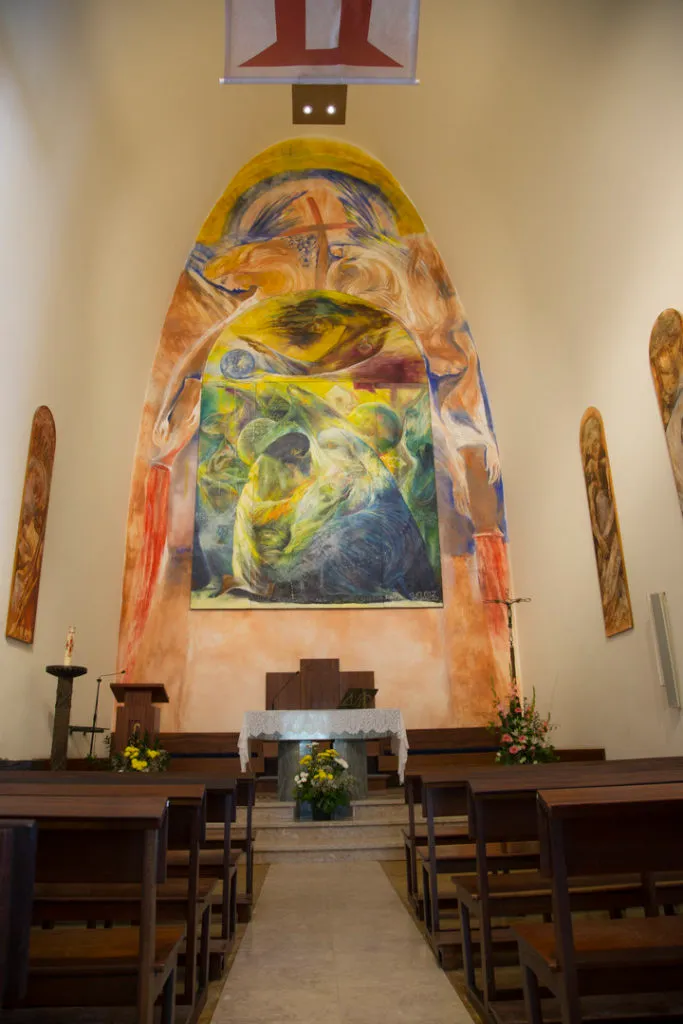
Within the four pillars of the Monument, symbol of the four cardinal points, is the Chapel of Our Lady of Peace, designed by Architect António Lino. The image of Our Lady is the work of Master Leopoldo de Almeida, being a replica of the same image that was offered to the Church of Santo Eugénio in Rome, on the Holy Year of 1950.
On May 17, 2006, the chapel was completely remodeled, changing the Main Chapel and the Chapel of the Blessed Sacrament. These changes included the collaboration of Architect João de Sousa Araújo.
The idea of removing the image of Our Lady from the Chapel of the Santíssimo and placing it in its current location was that of Architect Luís Virgínia Monteiro. In 2018, the image of the Sacred Heart of Jesus, by Marcos Augusto Dueñas, was also added.
In one of Cardinal Cerejeira’s writings the following is stated:
“… the Sanctuary of Christ the King will be tomorrow the National Sanctuary in the capital of the country, which will close the rainbow of faith, hope and peace, which rises from Fátima and passes through the Vatican…”. This text served as inspiration to Architect Sousa Araújo for the painting found in the Main Chapel.
In the fresco we see the 3rd Part of the 3rd Secret of Fátima, where we can see Pope John Paul II shot, next to a rough Cross. At his side the thousands of martyrs of the 20th Century. In every corner, an Angel pours the blood of these martyrs throughout the world into crystal vases.
In the center we have the triptych alluding to the last Apparition of Our Lady to the Little Shepherds, on October 13, 1917. At the top of this painting is Christ blessing the world, involving it in His Heart. On the opposite side of the Chancel there are painted three stained glass windows alluding to the Holy Trinity, according to the Apocalypse of Saint John.
In the Chapel of the Most Holy, the front of the Tabernacle is made up of two paintings painted in oil, by the Architect, the main one alluding to the Apocalypse of Saint John, which is topped by a triangular painting referring to the Holy Hour, as well as a painting with the sacred heart of Jesus and Immaculate Heart of Mary.
On the side doors are two paintings referring to the Revelations of Jesus made to Saint Margaret Maria Alacoque, in the 17th century. In the central body of the Chapel are the 14 Stations of the Cross, adapted to situations of suffering in present life.
At the entrance to the Chapel, on the right side, there is a model of the painting of the Main Chapel of the Basilica of Fátima; Above this painting is the model of the painting of the Main Chapel of the Cathedral of Nampula, Mozambique, referring to the glorification of Our Lady of Fátima by the people of Africa.
On the left side is the painting of Nossa Senhora da Conceição Aparecida, donated by the Embassy of the Federative Republic of Brazil to the Sanctuary in recognition of the connection between the Monument to Christ the King and Brazil, represented in the figure of its Patroness. On the windshield, there is a painting of the Custodian Angel of Portugal.
Sacristy
In this space we can observe the plaster model of the Image of Christ the King, four meters high, which served as a mold for the construction of the great Image. On the right wall there is a painting referring to Our Lady of Conception, Patroness of Portugal, according to the Apocalypse of St. John, where at the feet of the Virgin we see the Apostle writing this sacred book.
On the left wall there is another painting alluding to the twinning carried out between the Sanctuary of Christ the King and the Sanctuary of Christ the Redeemer in Rio de Janeiro, celebrated in 2009.
In this work we see Christ embracing the map of Brazil and Portugal, pointing his finger at the two places of worship. This hug is wrapped in the love of your heart, which means that the two countries are united by the same faith.
Cruz Alta
Venerated in Cova da Iria from October 13, 1951 (end of the Holy Year) until February 16, 2004, when it was removed due to the construction of the new Basilica. It was offered to the Sanctuary of Christ the King on February 13, 2007, and was inaugurated on May 17 of the same year and is in front of the monument.
With their presence, the message of peace from these sanctuaries is conveyed and symbolically the words spoken by the then Cardinal D. Manuel Gonçalves Cerejeira, on the day of the inauguration of this monument in front of the Image of Our Lady, coming from Capelinha of Apparitions: “…The Sanctuary of Christ the King stands as a complement to Your Sanctuary of Cova da Iria…” The Cruz Alta is flanked by an anchor offered by the Portuguese Navy and a heart that represents the revelation of Jesus’ love to Saint Margaret Maria Alacoque.
Way of the Cross
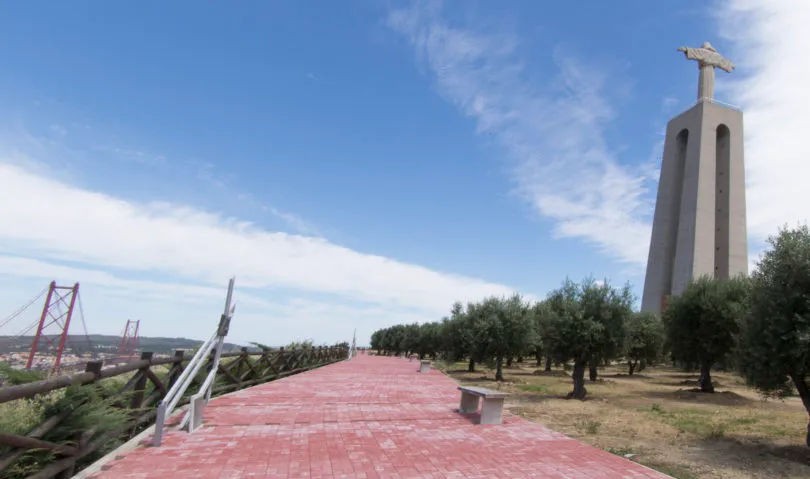
A Station of the Cross was built along the viewpoint. The 14 Stations are composed of crosses in perforated iron, so as not to shock the landscape, semi-lying, alluding to the position of Jesus when he carried His cross to Calvary. Each Station is enriched by a bronze bas-relief, with its own motifs. To help understand these mysteries, at the base are the relevant biblical texts and the respective meditations.
Rosary Pavilion

Due to the increase in demand for the Sanctuary from Parishes and Ecclesiastical Movements, to develop various activities here, given that the Chapel of Nossa Senhora da Paz only has capacity for around 200 people, it was necessary to think of a new space that would respond to the needs cultural, pastoral and spiritual aspects of the Sanctuary
A prefabricated solution was chosen due to the speed of its construction, however, due to the location where it was to be inserted, there was concern about quality and its integration into the already constructed complex. To this end, we asked for the collaboration of Mr. Architect Luíz Cunha.
Construction began in July 2014, and was inaugurated by the Bishop of Setúbal on March 6, 2016.The Pavilion has a seating capacity of 750 people, is air conditioned and is enriched with 22 oil paintings by French painter Serge Nouailhat. Twenty are alluding to the Mysteries of the Rosary and two are dedicated to the Sacred Heart of Jesus and the Immaculate Heart of Mary.
These works have a pedagogical function, aiming to instruct pilgrims in the meaning of reciting the Rosary. At the entrance to the Pavilion there is a sculpture alluding to the fall of Man (Gn 3, 1-24) and Mary, the new Eve, Mother of Salvation (Lc 1, 26-38).
Relics

When we step on the last step while climbing to see the monument, we find the Chapel of the Confidentes of the Sacred Heart of Jesus, inaugurated on May 17, 2008.
In it we find under the altar, the relics of Saint Margaret Mary Alacoque, to whom Jesus asked in the 17th century to establish a feast dedicated to his Sacred Heart, of Saint John Eudes, of Saint Faustina Kowalska, a Polish nun, to whom Jesus asked , in the 20th Century, that a festival dedicated to His Divine Mercy be instituted, on the Sunday following Easter, and the relics of Blessed Mary of the Divine Heart, whom Jesus in 1899 asked to write to Pope Leo XIII to consecrate the genre human to His Heart. These 4 confidants are represented in paintings also on display there.
Behind the altar you can see two low reliefs in bronze, which represent the Annunciation of the Angel to Our Lady and the Sacred Heart of Jesus who, with one hand on His Heart and the other pointing to the relief of the Annunciation, wants to convey to us the message that the unfathomable mystery of His love began in His Mother’s yes.
Annual Feast Day
Feast Day – 23rd November
The annual feast day of Sanctuary of Christ the King is celebrated on 23rd of November each year
Mass Timing
Tuesday – Sunday : 05.00 pm
Contact Info
Alto do Pragal,
Av. Cristo Rei,
2800-058 Almada
Phone No.
Accommodations
How to reach the Sanctuary
Airways
The nearest airport to the Sanctuary of Christ the King is Lisbon Airport (LIS) which is 11km away from the sanctuary.
Railways
The nearest railway station to the sanctuary of Christ the King is Almada Portugal which is 1.4 kilometres away from the sanctuary.

